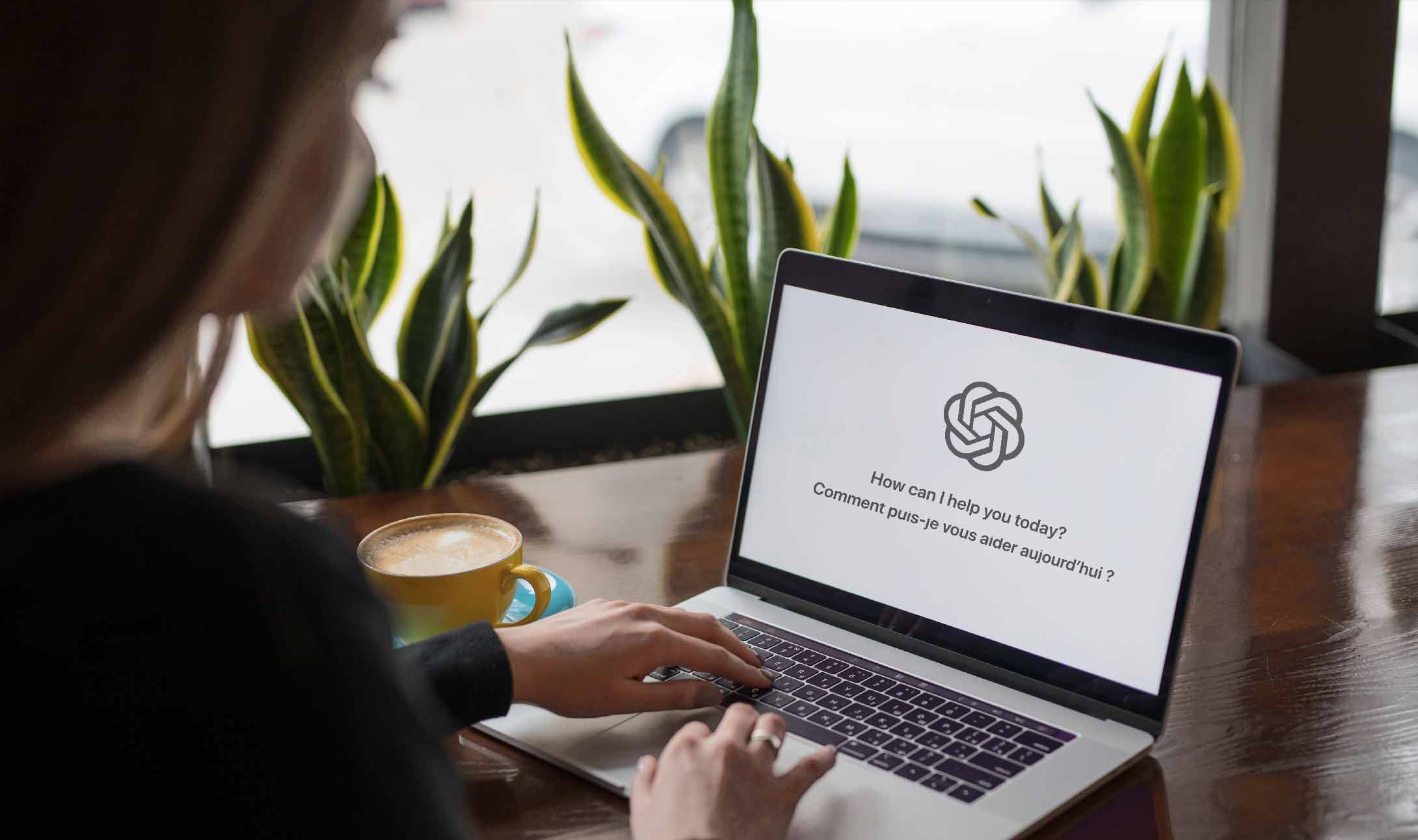Routine tasks take a lot of time and require significant resources. Recruiting, onboarding, training, and employee development can be very expensive. Traditional HR methods are not always effective and can lead to errors. Many people in HR departments recognize themselves in these common problems.
Do you want an easy solution to these issues? ChatGPT. Having appeared not so long ago, it continued to generate news almost every day. Nowadays, it’s not just a cool tech novelty anymore but a necessary tool that HR teams use with or without their boss’s knowledge.
ChatGPT is an example of a generative artificial intelligence (AI) solution. But what can it bring to human resources (HR)? In this article, we’ll overview its benefits and functions it can perform, from automating repetitive tasks to screening resumes and enhancing the overall employee experience.
ChatGPT in Human Resources (HR): How Can HR Use ChatGPT?
ChatGPT is an AI chatbot that relies on large language models (LLMs). These models use large volumes of textual data as training materials. Based on this information, they can reply to requests like humans and comprehend natural language.
OpenAI invested in ChatGPT development and presented the tool in late November 2022. Although ChatGPT has been in the news nonstop since then, it’s not the only AI chatbot that utilizes language models. Its major competitors include Google’s Gemini, Jasper, Neuroflash, and YouChat, to name a few.
This tool’s remarkable simplicity made it an overnight success. While its writing feels very human-like, you don’t have to configure complex software. All you need to sign up with ChatGPT is an email address. You get instant access to the free version and can update to ChatGPT 4, a premium and more advanced solution.
How does it work? Based on the word order it saw in its training data (over 300 billion words from books, the Internet, and conversations with users in its chat window), it guesses the word that will appear next in a sentence. For HR professionals, such a helper means more informed hiring decisions, personalized training plans, and a streamlined recruitment process. Let’s overview how human resources (HR) can benefit from ChatGPT.
Recruitment
HR departments have several options to amp up their recruitment process with the help of ChatGPT, such as:
- automate repetitive tasks;
- enhance candidate engagement;
- identify suitable candidates;
- write a job description.
Screening resumes and scheduling interviews are two important everyday tasks that may impact overall business performance. However, you may need to run through so many texts that you may potentially face information overload.
With ChatGPT for HR, HR departments can automate these chores and focus on decision-making, not searching for keywords in hundreds of relevant and not-so-relevant resumes. Automation reduces the chances of human errors, so you won’t miss the best talents due to fatigue or negligence.
ChatGPT can significantly enhance the candidate experience. For example, it can answer questions about the company in real time so that a candidate remains interested rather than waiting for HR professionals to respond.
ChatGPT excels at analyzing vast amounts of data in the blink of an eye. Just feed it with the information, and it’ll return precise results. If you need to find a person with particular skills, experience, and education, download the resume, insert it into the prompt box, and ask the following:
“Give me a list of skills, experience, and education level of this candidate and say whether it meets the following criteria:
[type in your requirements here].”
Here is an example response that allows HR professionals to pinpoint candidates who align with the company’s needs.
:

Onboarding
You’ve just brought new employees on board. Congratulations! That’s where the onboarding process begins, as you need to answer so many common HR-related questions about the following:
- company policies;
- procedures;
- employee benefits, and more.
You also need to provide guidance on completing the necessary paperwork. ChatGPT for HR can streamline this part, too. It can automate administrative tasks by scheduling orientation sessions, sending reminders about required training, and providing access to the needed resources.
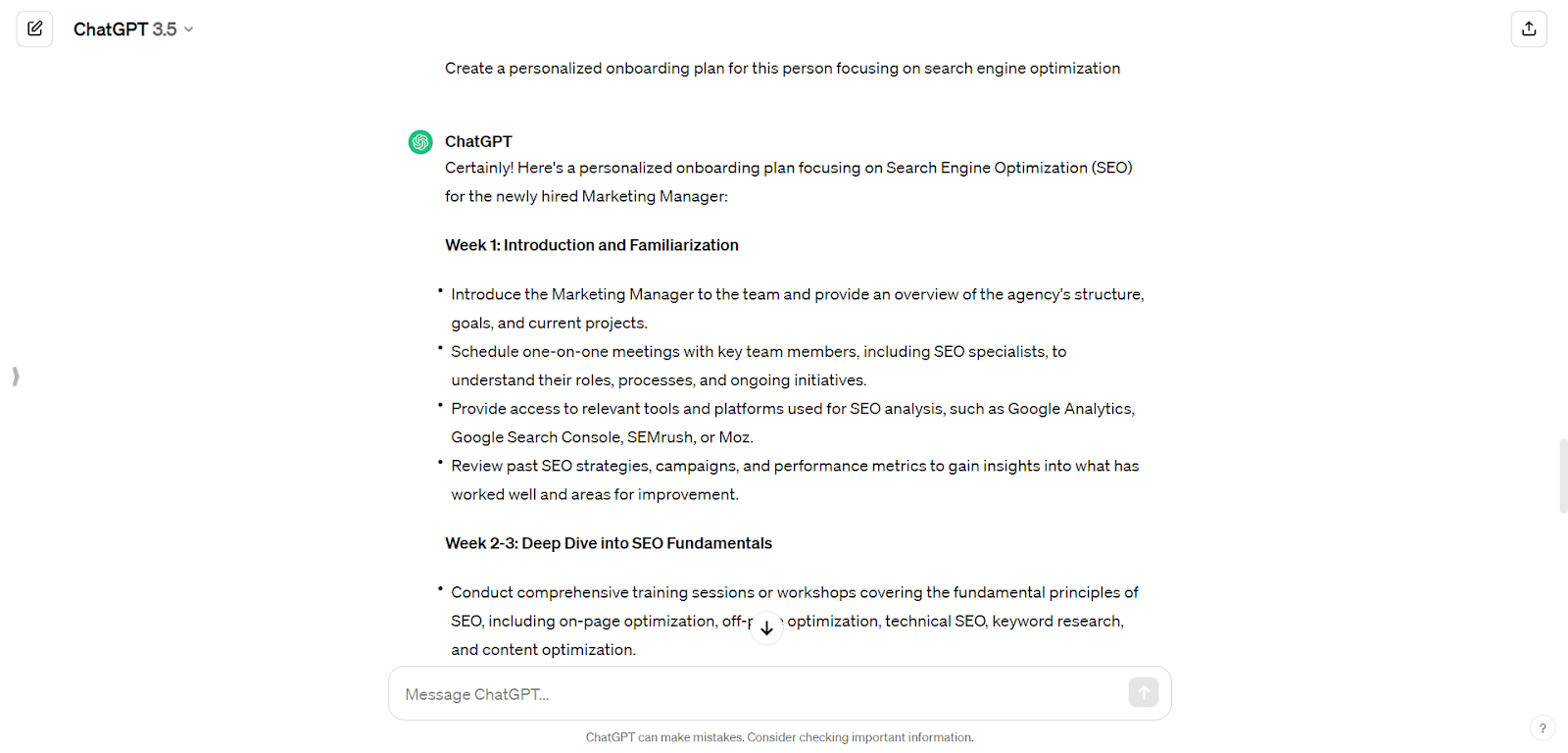
Employee Engagement
Upon completing employee onboarding, HR departments continue to interact with co-workers, such as answering frequently asked questions about policies, culture, procedures, and so on. That’s where the human resources team can also delegate some tasks to ChatGPT.
The tool sustains the conversation with the employees in the following ways:
- offers real-time support;
- provides personalized assistance;
- unlocks access to development opportunities.
The gains? Reducing confusion and uncertainty, cutting down on errors and delays, and boosting employee satisfaction. It can reduce employee turnover rates, lead to higher productivity, and improve employee engagement. ChatGPT makes sure you’re the company everyone wants to work at.
Let’s take answering FAQs as an example. Employees can ask ChatGPT questions like, “How do I apply for annual leave?” or “What are the company’s remote work policies?“
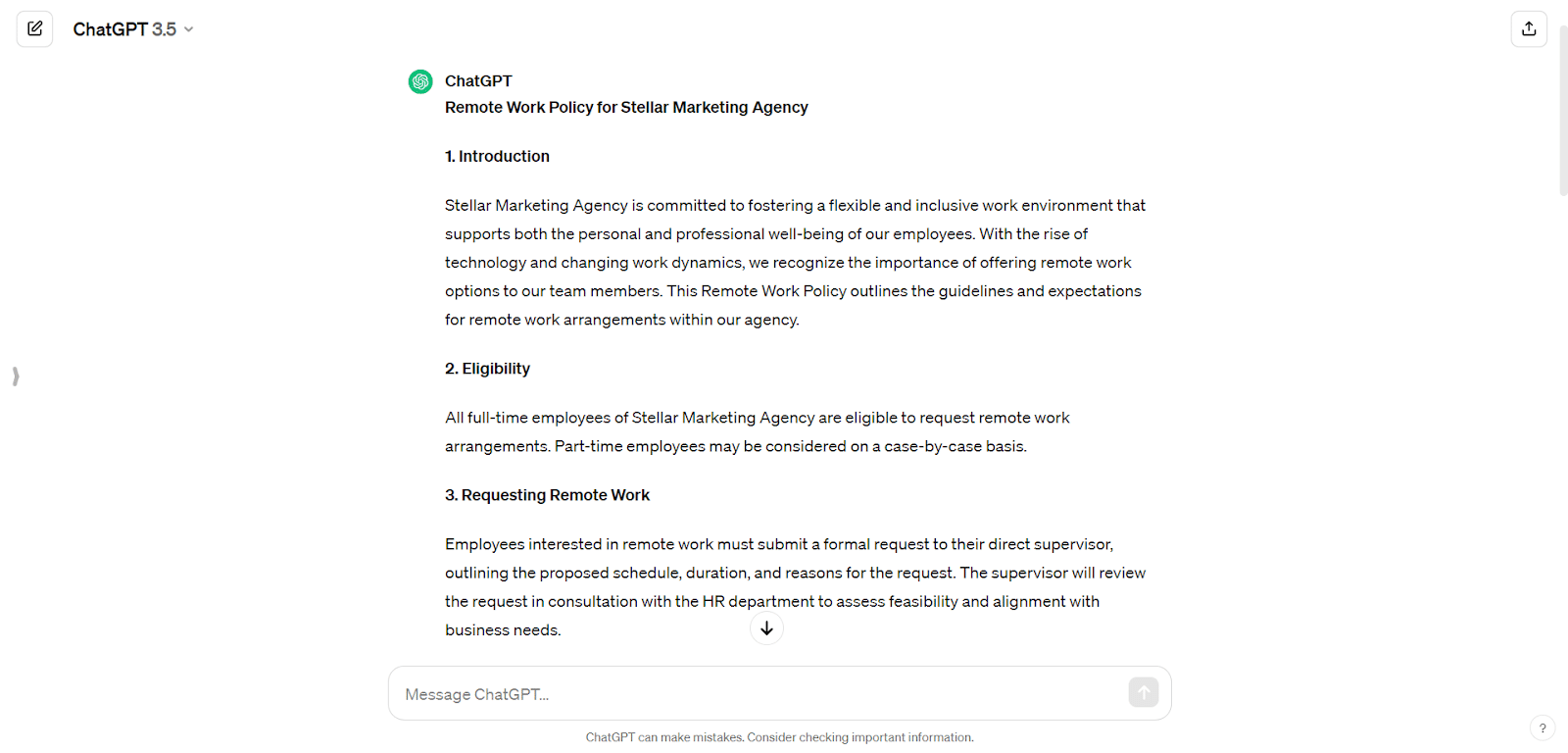
To make personalized results possible, HR professionals should first train ChatGPT with their company’s information and integrate it into its internal communication channels, such as Slack or Microsoft Teams.
Employee Training and Development
Training is essential to keeping staff competitive in the labor market. ChatGPT for HR can turn into an unbiased and intellectual educator, providing training materials when needed. For example, the person can ask, “Explain the step-by-step process for generating a monthly sales report using [Software Name].”
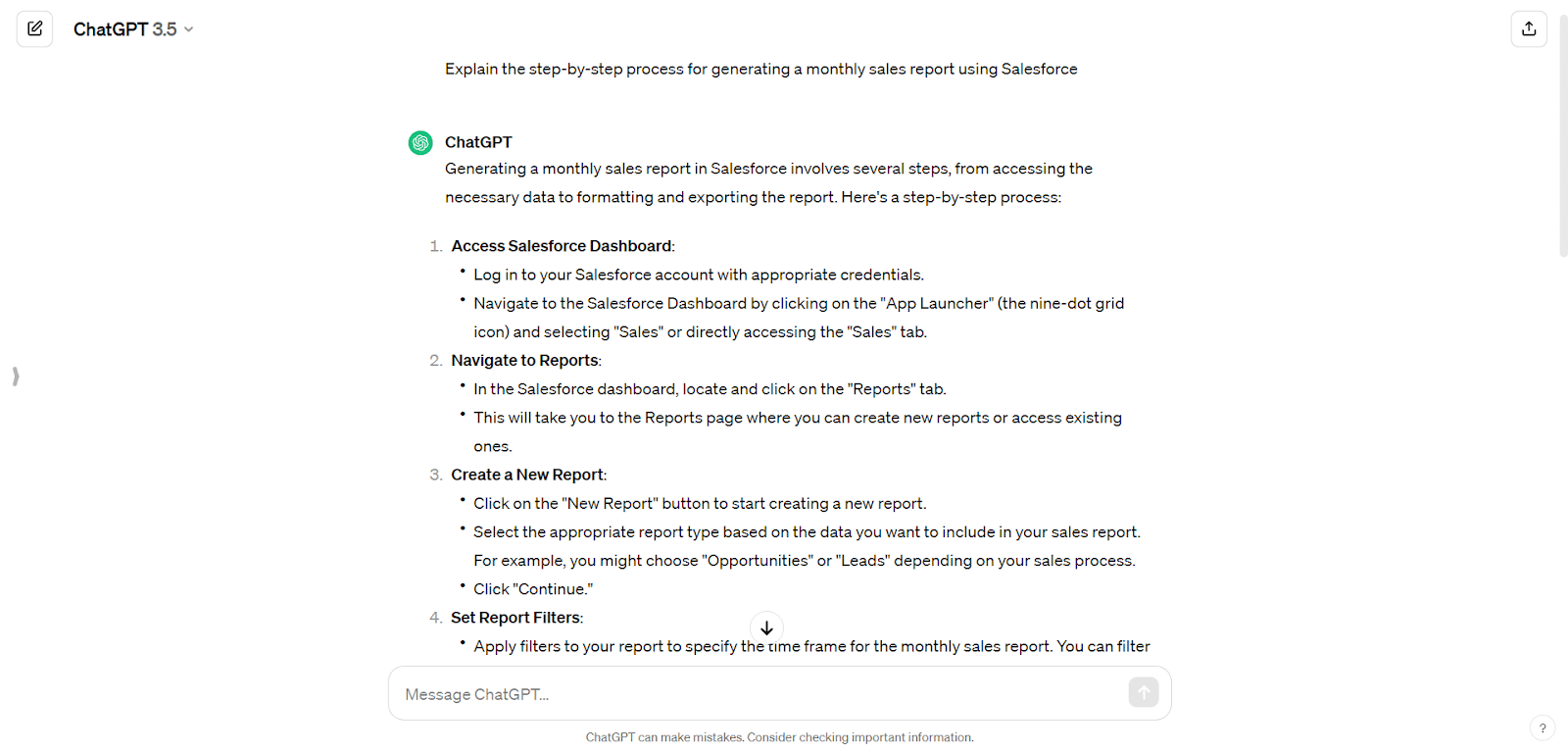
Note that the current software version, be it free or paid, can make mistakes. You need to acknowledge its limitations and not take the response at face value.
ChatGPT can provide a good first draft that’s easier to start with than a blank screen. In fact, the Writers Guild of America is thinking about permitting its application to screenwriting. However, it’s still crucial to double-check ChatGPT data for accuracy before copying, pasting, and distributing the results.
By leveraging ChatGPT in HR departments, you can create personalized training plans according to individual employees’ needs and skill sets. This tool ensures professional development opportunities are both relevant and impactful.
Employee Performance Management
The person has been working at your company for some time. But what are their results? Does their performance drive business success? Maybe it’s time to reward them for their achievements or suggest another course of action if things don’t go as desired.
The performance management process may involve various tasks:
- conducting performance evaluations;
- drafting feedback;
- setting goals;
- creating performance improvement plans.
At this stage, you can employ ChatGPT. For instance, HR team members can ask, “Based on an average project completion rate of 75% and customer satisfaction score of 80%, how can I structure my employee performance feedback session to highlight areas of improvement and set goals for the next quarter?“
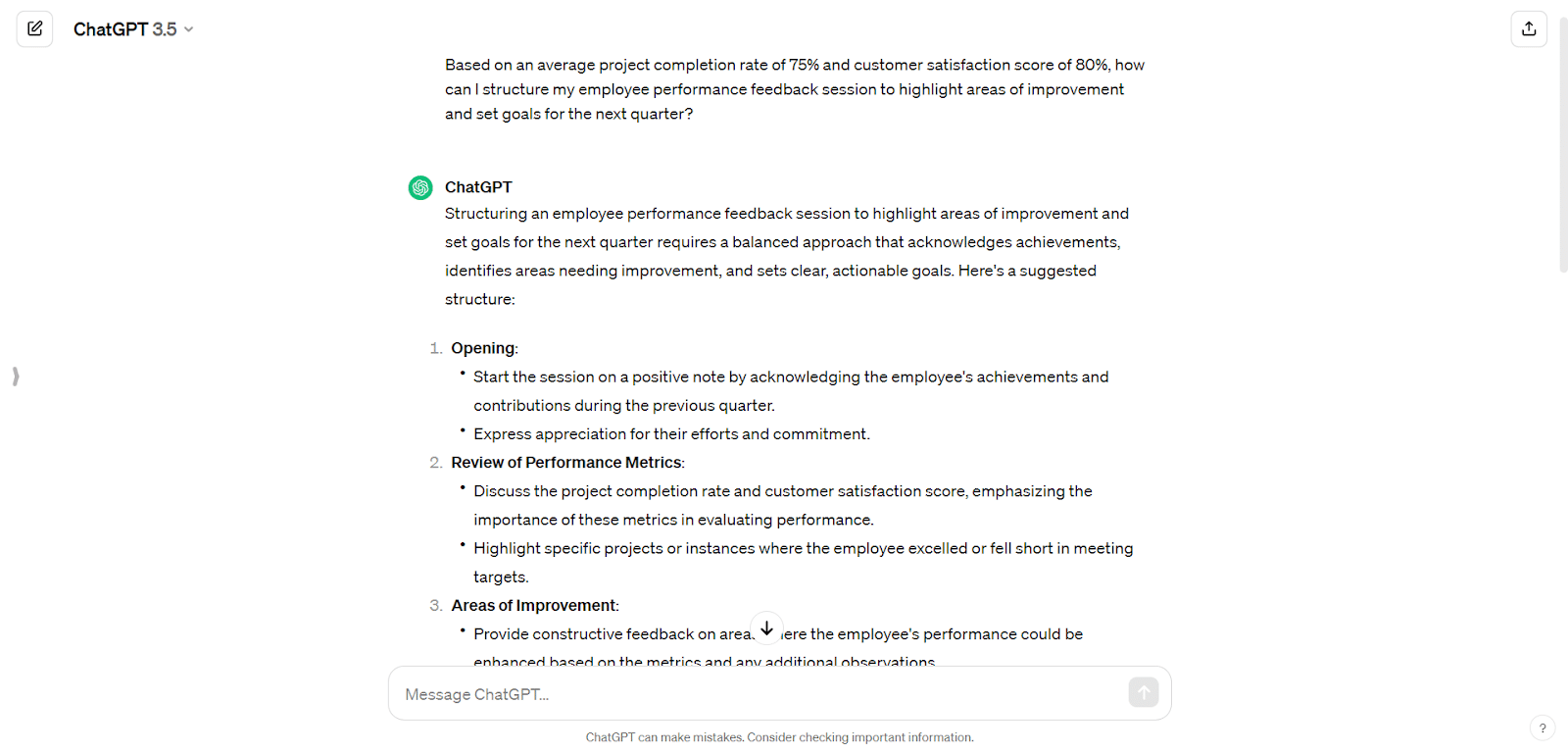
With this app, HR professionals can access real-time data on worker performance and later on set up alerts to reach specific managers and the human resources team.
Compliance
Compliance in HR departments encompasses various areas, such as:
- tax regulations;
- local and national regulations;
- health and safety protocols;
- employment laws.
Your company and employees should adhere to these norms to avoid legal or reputational risks, improve the image, and ensure a satisfied workforce. If you’re bogged down with the paperwork, try the following ChatGPT request:
“Explore and summarize the most recent local, state, and federal laws that are pertinent to our HR policies. Focus on compliance areas such as:
- labor laws;
- discrimination;
- workplace safety;
- employee benefits.
Additionally, analyze our existing HR policies and practices for consistency and accuracy in light of these regulations. Provide recommendations for any adjustments needed to ensure full compliance and to maintain best practices in HR management.”

You not only need to follow these recommendations but also monitor employee compliance. It can be daunting. That’s where ChatGPT can come in handy as well.
For example, if your HR departments track attendance, you may configure the tool to log the time and date when the employee sends a message saying, “Checking in for work.” If they haven’t checked in by a specific time, ChatGPT can flag potential unexplained absences. Overall, HR departments ensure a safe and equitable work environment with the help of Chat GPT.
HR Chatbots
OpenAI, the ChatGPT developer, not only offers an app with a user-friendly interface. It also lets you build custom ChatGPT-powered chatbots using API. Here is where you can deploy the chatbot:
- the company intranet;
- HR software platforms;
- communication tools like Slack, Microsoft Teams;
- as a standalone application on the company’s HR portal.
This move offers a level of ownership in terms of the application’s functionality within your business environment. For example, you can customize it, control the data, and brand the interface.
At the same time, you still leverage the cutting-edge GPT technology. As such, it enhances the overall employee experience, making it easier for staff to obtain up-to-date information when they need it.
Cutting Costs with ChatGPT for HR
Wouldn’t it be great if HR tasks could be less time-consuming and expensive? That’s the dream! We’ve already overviewed how ChatGPT can tackle the first problem. But how is it reflected in the company’s budget and bottom line? Easy. Consider the following scenario:
- Before ChatGPT: Human resources (HR) staff spend an average of 30% of their time answering employee questions.
- After ChatGPT: The personnel can focus on higher-value tasks. For example, if an HR employee’s annual salary is $60,000, automating routine inquiries can save up to $18,000 per employee in redirected labor costs.
Besides direct cost reduction, HR professionals boost their efficiency, so you may not need to hire new employees.
Navigating ChatGPT HR Challenges
You may have heard that AI might eventually replace people. Plus, it relies on sensitive data, and no company is eager to compromise it. Add to this the employee resistance to anything new. Voila. Now, you see that integrating ChatGPT into HR departments has become an even bigger headache than the tasks before AI implementation.
Indeed, this process isn’t without its hurdles. Here are strategies to overcome some of them.
Ethical Implications
Various studies have shown that AI models can promote social stereotypes. This may worsen the situation for disadvantaged people and exacerbate existing disparities.
But don’t jump to conclusions. The problem stems from the data on which AI systems were trained.
These days, the AI community is debating how to reduce the bias that comes from using large language models. Here are some insights:
- Train the model using diverse datasets and clean them in case of stereotypes or unfair assumptions.
- Regularly test ChatGPT’s outputs for unintended biases.
As you can see, it’s impossible to replace people with robots. You need to always have a human in the loop, especially for critical decisions like hiring or disciplinary actions. AI can suggest, but humans should have the final say, ensuring fairness and empathy are part of the equation.
Security and Privacy
ChatGPT needs information to train future models. Due to this, it records conversations and may replicate personal details entered by a user in its later outputs. It may sound scary, especially if there’s something you wouldn’t want to share publicly.
There is a simple rule: Don’t input private or sensitive data, for example, a harassment claim made against a worker or an employee’s medical leave of absence. However, it’s still acceptable to write job descriptions using ChatGPT for HR.
Not inserting payment details, health information, or personal information is all about compliance that HR professionals must ensure. Keep in mind that even if the original copy is removed, the tool may still reveal private data.
This means anyone can question ChatGPT about confidential details they may have input, such as:
- trade secrets;
- plans for mergers or layoffs;
- particular employee performance issues.
AI may use these facts in its responses. As evidenced by Cyberhaven’s research, 11% of the information that employees paste into ChatGPT is private. So, it’s already happening.
Resistance to Change
It’s always hard to adapt to new things. Help employees to smoothly transition to using ChatGPT, such as:
- Educate and involve: Scheduling training sessions for HR teams is no less critical than for other specialists. Show them by example, and let them learn the tool before raising expectations.
- Highlight the benefits: Explain how ChatGPT and AI can simplify their work:
– automate repetitive tasks;
– identify potential candidates;
– facilitate easy access to information about compliance-related matters;
– write a job description.
- Start small and scale: Choose the administrative tasks that are the easiest to complete with ChatGPT. When people feel more comfortable with the tool, they may find other ways to employ it.
ChatGPT and HR Professionals: To Sum Up
ChatGPT is a generative AI solution. It transforms the work of various specialists, including marketing, sales, copywriting, and other fields. Human resources are no exception, with ChatGPT improving employee engagement and helping HRs manage the company’s workforce efficiently.
While it can develop high-quality, personalized, and engaging texts, it can also be a valuable training tool, giving employees access to skill-building resources. Whether you want to draft an effective job description, automate administrative tasks, elevate employee engagement, or simplify performance management, ChatGPT can be a valuable asset.
In the future, HR will inevitably incorporate ChatGPT and related AI technologies. While some believe AI is coming for their jobs, others think it’ll allow them to work fewer days each week. However, one thing that is certain at this point is that AI will get better. So, why not adopt ChatGPT for HR department duties to start capitalizing on it now?
Art Malkovich is co-founder and Chief Executive Officer of Onilab, a full-service eCommerce agency. Being an experienced developer and project manager, he keeps up to date with the latest trends in headless commerce, online store development and migration, SaaS, and UX/UI design.
